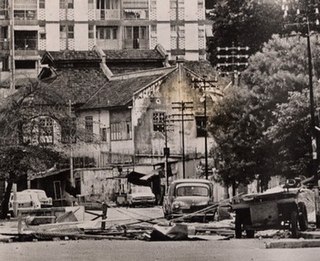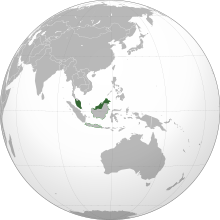
Kuala Lumpur, officially the Federal Territory of Kuala Lumpur and colloquially referred to as KL, is a federal territory and the capital city of Malaysia. It is one of the fastest-growing cities in Asia and the largest city in Malaysia, covering an area of 243 km2 (94 sq mi) with a census population of 1,982,112 as of 2020. Greater Kuala Lumpur, also known as the Klang Valley, is an urban agglomeration of 7.564 million people as of 2018. It is among the fastest growing metropolitan regions in Southeast Asia, both in population and economic development.
Politics of Malaysia takes place in the framework of a federal representative democratic constitutional monarchy, in which the Yang di-Pertuan Agong is head of state and the Prime Minister of Malaysia is the head of government. Executive power is exercised by the federal government and the 13 state governments. Legislative power is vested in the federal parliament and the 13 state assemblies. The judiciary is independent of the executive and the legislature, though the executive maintains a certain level of influence in the appointment of judges to the courts.

Tun Haji Abdul Razak bin Dato' Hussein was a Malaysian lawyer and politician who served as the second Prime Minister of Malaysia from 1970 until his death in 1976. He also served as the first deputy prime minister of Malaysia from August 1957 to September 1970. He is referred to as the Father of Development.

Tun Hussein bin Dato' Onn was a Malaysian lawyer and politician who served as the third Prime Minister of Malaysia from the death of his predecessor Abdul Razak Hussein in 1976 to his retirement in 1981. Moreover, he was the Member of Parliament (MP) for Sri Gading from 1974 to 1981, representing Barisan Nasional (BN) and United Malays National Organisation (UMNO). He was granted the soubriquet Father of Unity.

The 13 May incident was an episode of Sino-Malay sectarian violence that took place in Kuala Lumpur, the capital of Malaysia, on 13 May 1969. The riot occurred in the aftermath of the 1969 Malaysian general election when opposition parties such as the Democratic Action Party and Gerakan made gains at the expense of the ruling coalition, the Alliance Party.

Tuanku Sir Abdul Rahman ibni Almarhum Tuanku Muhammad was the first Yang di-Pertuan Agong of the Federation of Malaya and the eighth Yang di-Pertuan Besar of Negeri Sembilan.
The states and federal territories of Malaysia are the principal administrative divisions of Malaysia. Malaysia is a federation of 13 states (Negeri) and 3 federal territories.

Tun Dr. Ismail bin Abdul Rahman was a Malaysian politician who served as the second Deputy Prime Minister of Malaysia from September 1970 to his death in August 1973. A member of the United Malays National Organisation (UMNO), he previously held several ministerial posts.

The Malaysian Houses of Parliament, is a complex where the Malaysian Parliament assembles. The structure is located at the Perdana Botanical Gardens in Kuala Lumpur, close to the Malaysian National Monument.

Sultan of Selangor is the title of the constitutional ruler of Selangor, Malaysia who is the head of state and head of the Islamic religion in Selangor. The current monarch, Sultan Sharafuddin Idris Shah ascended the throne on the death of his father, on 22 November 2001.
Lembah Pantai is a sub-district and parliamentary constituency in south-western Kuala Lumpur, Malaysia. Constituencies adjacent to Lembah Pantai are Seputeh, Segambut and Bukit Bintang. The total number of population is 148,094 as of 2020 census.

This article lists important figures and events in Malayan public affairs during the year 1957, together with births and deaths of significant Malayans. Malaya became independent from British colonial rule on 31 August 1957.
This article lists important figures and events in Malayan public affairs during the year 1955, as well as births and deaths of significant Malayans.

Kuala Lumpur is the largest city in Malaysia; it is also the nation's capital. The history of Kuala Lumpur began in the middle of the 19th century with the rise of the tin mining industry, and boomed in the early 20th century with the development of rubber plantations in Selangor. It became the capital of Selangor, later the Federated Malay States, and then Malayan Union, and finally Malaya and Malaysia.

Khalid bin Abdul Samad is a Malaysian politician who served as the Minister of Federal Territories in the Pakatan Harapan (PH) administration under former Prime Minister Mahathir Mohamad from July 2018 to the collapse of the PH administration in February 2020 and the Member of Parliament (MP) for Shah Alam from March 2008 to November 2022. He is a member, Communications Director and State Chairman of Kelantan of the National Trust Party (AMANAH), a component party of the PH coalition and was a member of the Malaysian Islamic Party (PAS), a former component party of the former Pakatan Rakyat (PR) and Barisan Alternatif (BA) coalitions. He is also the younger brother of Shahrir Abdul Samad, former Minister and MP of the United Malays National Organisation (UMNO), a component party of the Barisan Nasional (BN) coalition. Before PH and BN formed the federal coalition government in November 2022, they were opposing politically as both of them were in opposing political sides.
Desa Tun Hussein Onn is the Malaysian Armed Forces residential area in Kuala Lumpur, Malaysia. This special residential area is located near Setiawangsa in the south and Wangsa Maju in the north. It is located beside the Malaysian Ministry of Defence.

The Peace Agreement of Hat Yai (1989) marked the end of the Communist insurgency in Malaysia (1968–1989). It was signed and ratified by the Malayan Communist Party (MCP), and the Malaysian and Thailand governments at the Lee Gardens Hotel in Hat Yai, Thailand, on 2 December 1989.
The following is an alphabetical list of articles related to Selangor.
Kampung Padang Balang or Padang Balang is the oldest surviving traditional village in Kuala Lumpur, Malaysia. It was circumferenced by Gombak Road, Jalan Kampung Bandar Dalam, Duta–Ulu Klang Expressway (DUKE), Kuala Lumpur Middle Ring Road 2 and Gombak River.
Anarchism in Malaysia arose from the revolutionary activities of Chinese immigrants in British Malaya, who were the first to construct an organized anarchist movement in the country - reaching its peak during the 1920s. After a campaign of repression by the British authorities, anarchism was supplanted by Bolshevism as the leading revolutionary current, until the resurgence of the anarchist movement during the 1980s, as part of the Malaysian punk scene.













